All the solutions provided in McGraw Hill My Math Grade 5 Answer Key PDF Chapter 2 Review will give you a clear idea of the concepts.
McGraw-Hill My Math Grade 5 Chapter 2 Review Answer Key
Review
Vocabulary Check
Match each word to its definition. Write your answers on the lines provided.


Answer:
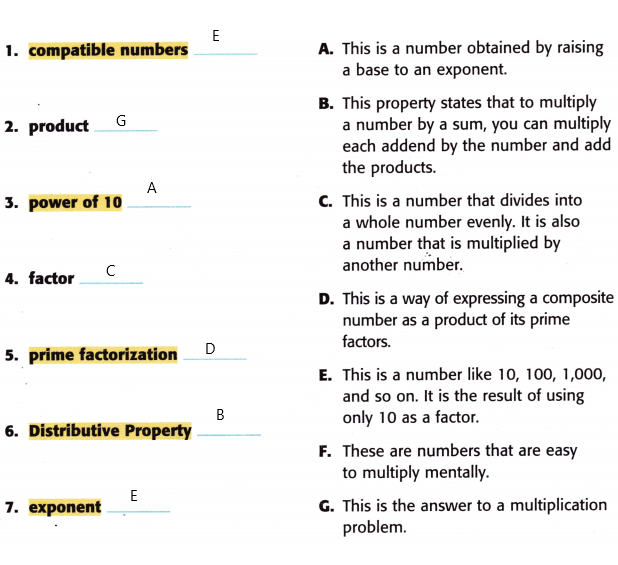
Concept Check
Find the prime factorization of each number.
Question 10.
12 = ______
Answer:
4 × 3 or 22 × 3
Explanation:
Given,
The number is 12.
The factors of 12 are 4 × 3 = 2 × 2 × 3
The prime factorization of each number is 4 × 3 or 22 × 3.
Question 11.
42 = ____
Answer:
7 × 6
Explanation:
Given question is
42
The factors of 42 are 6 × 7
The prime factorization of the given number is 7 × 6.
Write each product using an exponent.
Question 12.
10 × 10 = ____
Answer:
100 or 102
Explanation:
Each product uses an exponent that is 102
Question 13.
5 × 5 × 5 × 5 = ____
Answer:
54
Explanation:
Each product uses an exponent that is 54
Find each product mentally.
Question 14.
73 × 102 = ___
Answer:
7300
Explanation:
Given multiplicand is 73 and the multiplier is 102
By multiplying both multiplicand 73 and multiplier 102 , we get the value as 7300.
The product of the given number is 73 × 102
73 × 10 × 10
7300
Question 15.
60 × 40 = ____
Answer:
2400
Explanation:
Given multiplicand is 60 and the multiplier is 40.
By multiplying both multiplicand 60 and multiplier 40, we get the value as 2400
The product of the given number is 60 × 40 = 2400
Estimate. Then multiply. Use your estimate to check your answer.
Question 16.

Answer:
2592
Explanation:
Given multiplicand is 72 and the multiplier is 36.
By multiplying the both multiplicand 72 and multiplier 36, we get the value as 2592.

Question 17.

Answer:
1932
Explanation:
Given multiplicand is 23 and the multiplier is 84.
By multiplying both multiplicand 23 and multiplier 84, we get the value as 1932.
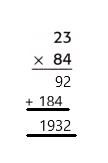
Question 18.

Answer:
20544
Explanation:
Given multiplicand is 321 and the multiplier is 64.
By multiplying both multiplicand 321 and multiplier 64, we get the value 20544.

Find each product mentally using the Distributive Property. Show the steps that you used.
Question 19.
8 × 71 = ____
Answer:
568
Explanation:
Given question is
8 × 71
Given multiplicand is 8 and the multiplier is 71.
By multiplying both multiplicand 8 and multiplier 71, we get the value as 568.
The product of the given number is 568.
Question 20.
6 × 83 = ____
Answer:
498
Explanation:
Given multiplicand is 6 and the multiplier is 83.
By multiplying both multiplicand 6 and multiplier 83, we get the value as 498.
The product of the given number is 498.
Problem Solving
For Exercises 21-23, use the following information. Then estimate to find the distance sound travels through each material in each given time.
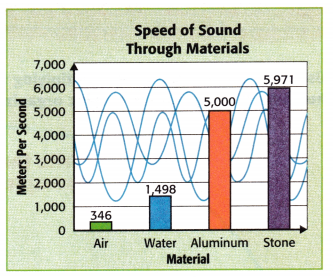
Sound travels through different materials at different speeds. For example, the graph shows that in one second, sound travels 5,971 meters through stone. However, it travels only 346 meters through air in one second.
Question 21.
air, 20 seconds
_________
Answer:
6920 m
Explanation:
From the given question we know the speed of the sound in air is 346 meters per second.
The distance in 20s is
346 × 20 = 6920 m
Question 22.
stone, 12 seconds
_________
Answer:
Explanation:
From the given question we know the speed of the sound in stone is 5,971 meters.
The distance in 12 seconds is
5971 × 12 = 71652 m
Question 23.
Estimate how much farther sound travels through stone in 17 seconds than through aluminum in the same time.
Answer:
Sound travels 16507 m farther through stone in 17 seconds than through aluminium.
Explanation:
Given,
Speed of sound in aluminium = 5000 meters per second
Speed of sound in stone = 5971 meters per second
Time taken = 17 seconds
Distance travelled by sound in aluminium in 17 seconds = 5000 × 17
Distance = 85000 m
Distance travelled by sound in stone in 17 seconds = 5971 × 17
Distance = 101507
Difference in distance travelled = 101507 – 85000
Difference = 16507 m
Hence, Sound travels 16507 m farther through stone in 17 seconds than through aluminium.
Question 24.
Sylvia is saving to buy a new terrarium for her iguana. She saves $2 the first week, $4 the second week, $8 the third week, and so on. How much total money will she save in 5 weeks? Solve by completing the table.
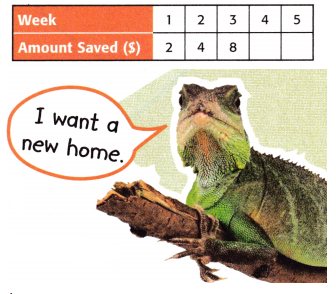
Answer:
$30
Explanation:
Syliva saving: $2, $4, $6, $ —
the sum of total money saved in 5 week
S5 = n ÷ 2 (2a + (n -1) d
here n = 5, a = 2, d = 2
S5 = 5 ÷ 2 (4 + 4 × 2)
S5 = 5 ÷ 2 (4 + 8)
= 30
Hence sum is $30.
Test Practice
Question 25.
Colin bought 7 flats of flowers. Each flat contains 24 flowers. How many flowers did he buy?
A. 140 flowers
B. 154 flowers
C. 168 flowers
D. 200 flowers
Answer:
168 flowers
Explanation:
Colin bought 7 flats of flowers
Each flat contains 24 flowers
He bought 168 flowers
7 × 24 flowers.
Reflect
Use what you learned about multiplying whole numbers to complete the graphic organizer.
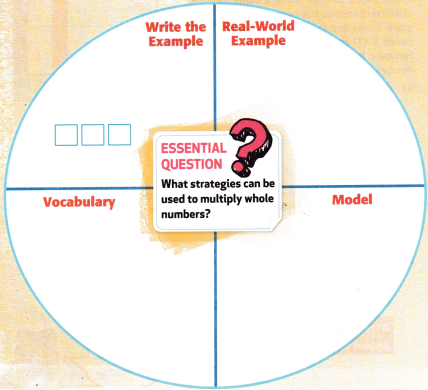 c
c
Now reflect on the ESSENTIAL QUESTION? Write your answer below.
______________________________
______________________________
______________________________
Answer:
First place the numbers so that one number is above the other and the numbers in ones, ten’s place are placed in order.
Next, multiply the digit in the one’s place by the digit in the one’s place of the multiplicand.